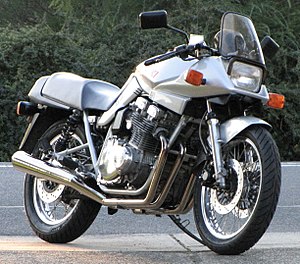Suzuki Katana

Suzuki Katana GSX1100
|
|
| Manufacturer | Suzuki |
|---|---|
| Also called | GS1100S (North America) |
| Production | 1981–2006 |
| Class | Sport bike |
| Related |
Suzuki GSX-R600 Suzuki GSX-R1000 |
The Suzuki Katana is a sport motorcycle designed in 1979–1980 by Target Design of Germany for Suzuki.
The Katana name was later applied to a range of sport touring motorcycles in North America through the 2006 model year (also offered in Europe but without the Katana moniker), and starting at the change of the millennium to a line of 49 cc/50 cc scooters in Europe.
The Katana's design started when Suzuki hired Hans Muth, ex-chief of styling for BMW, to update the company's image. The three-man Target Design team consisted of Muth, Jan Fellstrom and Hans-Georg Kasten. Kasten was still with Target Design as of 2003.
The design worked through several variations, with the public being allowed to see the ED1 and ED2 versions. This original design was a 650 cc (40 cu in) model called the ED-1 (European Design 1). The ED1 design featured a forward nose and a shaped, blended fuel tank with a merged fuel tank-to-seat arrangement at a time when squared off fuel tanks and flat-faced bolt-on accessory fairings were the norm. The design also incorporated favorable aerodynamics, with a special emphasis placed on high-speed stability, and was repeatedly wind-tunnel tested in Italy. The same generalized design forms had already been used early in 1979 for a one-off MV Agusta from the same design team, which never saw production.
The production Katana of 1981 differed only slightly from the prototype; changes included a small wind deflector screen, paired mufflers, and black accent paint on the front fender and air box covers. Target's design philosophy - keeping components compact and close-fitting - was applied to all areas of the bike's design to reduce production costs, weight, and number of components required. Examples include the overlapping dials on the instrument cluster, and the offset petrol filler which allowed for a clean continuous seam weld on the tank.
In late 1980 when the GSX1100S Katana hit the street, it was claimed by Suzuki to be the fastest mass-production motorcycle in the world, ensuring the new looks were matched by unprecedented performance levels. So radical was the design departure from previous mass-market cycles that most major motorcycle magazines of the era thought the design would not appeal to the masses. Nevertheless, it was a sales success, and the motorcycle had a lasting impact on motorcycle design. Portions of the design ethos are still visible in many current sport motorcycles, including the faired-in aspects of both the seat and the tank.
...
Wikipedia
